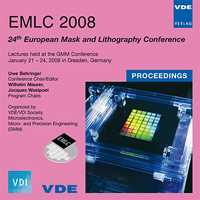Photomask cleaning process improvement to minimize ArF haze
Konferenz: EMLC 2008 - 24th European Mask and Lithography Conference
21.01.2008 - 24.01.2008 in Dresden, Germany
Tagungsband: EMLC 2008
Seiten: 6Sprache: EnglischTyp: PDF
Persönliche VDE-Mitglieder erhalten auf diesen Artikel 10% Rabatt
Autoren:
Graham, Michael; McDonald, Andrew (Photronics (UK) Ltd, Trafford Wharf Road, Manchester M17 1PE, UK)
Inhalt:
Growth of "haze" defects on photomasks exposed in ArF lithography is recognized as a serious problem. Haze defects that have grown to detectable sizes can be analysed in situ by techniques such as EDX or Raman, but to analyze at the photomask manufacturing stage requires extraction of residues by solution in DI water. The effect of extraction conditions, including surface area and material, water volume, time, and temperature, has been studied. A standard method to compare residual ion levels is proposed. Various methods for reducing residual ion levels from the photomask cleaning process have been published. These include SPM reduction, oxygen plasma, SC1 dilution, Megasonic agitation, hot rinse, UV exposure, thermal bake, ozone water, ozone gas, and hydrogenated water. Critical parameters for the cleaning process, besides residual ion levels and contamination removal efficiency, include CD shift, AR/chrome damage, scatter bar damage, and on phase shift masks, the change in phase and transmission. An optimized process combining conventional and novel techniques is described. Data is presented to show the importance of controlling all resist strip and clean processes, not just the final clean. It has achieved sulphate levels of 0.2ng/cm2 (well below the critical level for haze growth), as well as improved results for the other critical parameters. This process has been demonstrated to allow ArF exposure of large numbers of wafers without the appearance of haze defects.


